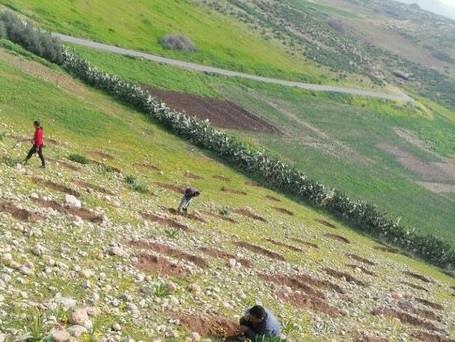FAO, ICARDA establish small-scale agro-silvo-pastoral test site in Jordan to raise awareness, promote ecosystem services enhancement

The Food and Agriculture Organization of the United Nations in collaboration with The International Center for Agricultural Research in Dry Area (ICARDA), NGO Watershed and Development Initiative (WADI) for Sustainable Ecosystems Development and the local community, and a local Community Based Organization (CBO), called the "Sustainable Agriculture Association" in the northern Jordan Valley under the regional project “Water Efficiency, Productivity and Sustainability in the NENA region” established a small-scale agro-silvo-pastoral test site aiming at enhancing water use efficiency and productivity in dryland agriculture.
Mismanagement, deforestation, and overgrazing have led to the degradation of the steep sloped side Wadi’s in Jordan. Moreover, exploited vegetation and soils have limited retention functions and led to distinct surface runoff and massive sediment fluxes, which negatively affected the downstream-irrigated production system through, e.g. siltation of reservoirs.
A small-scale testing of rehabilitation implementation, and an ex-ante assessment of the potential for large-scale impacts on the areas’ Eco-hydrology were established in Jordan. In this way, preparing the ground for sustainable agricultural management that can eventually benefit local communities through enhanced ecosystems that provide livestock feed and other viable services in Jordan’s rain-fed and agro-pastoral Wadi’s environments. This activity addressed agro-silvo-pastoral approaches that rehabilitate ecosystem functionalities and services of the largely degraded Jordan Valley’s side Wadi’s yielding surface water (runoff) towards the lowlands’ irrigated production system. This activity also focused on the local community’s interactions with the available resources: land, water, and energy.
The small-scale agro-silvo-pastoral test site (one ha) was established in the north Jordan Valley in February 2022 to initiate rangeland restoration using the in-situ micro water harvesting pits (Semi-circular bunds) and planting native rangeland species (Atriplex Halimus). Semi-circular bunds harvesting technique were selected based on the land cover, soil texture, and depth. The pilot implementation was conducted at an approximately 17 percent inclined hillslope. The desktop design of the site concluded that the best shrub target area and catchment area should be between 8 and 9 m2, the spacing between lines should be around 3 meters along the hill slope and the spacing between shrubs should be around 2.5 m (lateral spacing).
Prior to the implementation, an awareness session on "the importance and ways to have healthy rangelands" was conducted to the local community at "Sustainable Agricultural Association", where twenty participants attended the session. Participants in the theoretical session were also engaged in the practical implementation. During the implementation, hands-on training was also provided on the proper land preparation for restoration using micro water harvesting techniques and proper out-planting practices to ensure successful rangeland restoration. The local community appreciated the new skills and experiences they gained to enhance their livelihood. They listed that the in-situ micro water harvesting and planting of rangeland species have a promising benefits in the shorter and longer-term.
Such interventions will increase capturing water in the pits and will maintain a more ample grazing opportunity for herders. The prolonged grazing period and improved biomass are projected to increase local herders’ income by improving animal health and production. The technology also provides livestock fodder and several ecosystem services such as: reducing soil erosion and runoff rates, increasing soil carbon storage and sequestration, and improving biodiversity and biomass. This activity is implemented under the regional project “Implementing the 2030 Agenda for water efficiency/productivity and water sustainability in NENA countries” directly under the Regional Water
Scarcity Initiative. This project is funded by the Swedish International Development Cooperation Agency.
